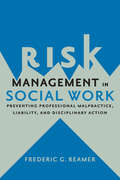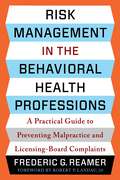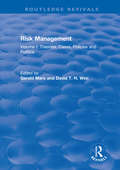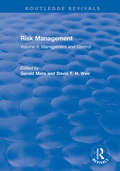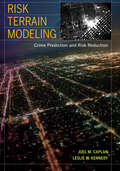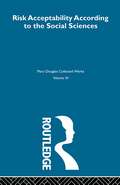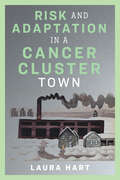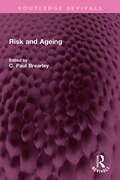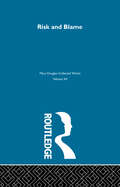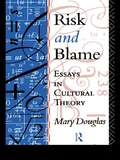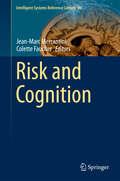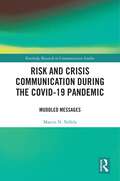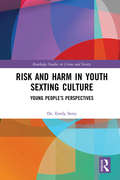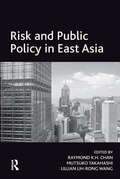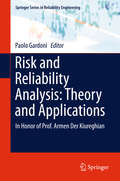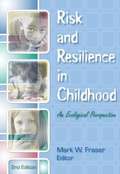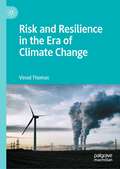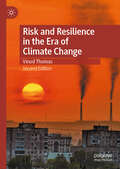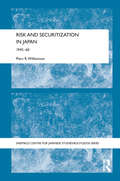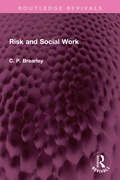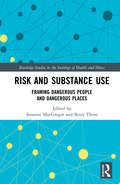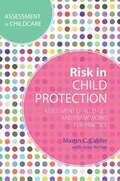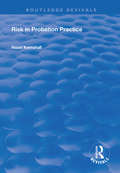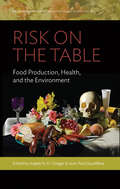- Table View
- List View
Risk Management in Social Work: Preventing Professional Malpractice, Liability, and Disciplinary Action
by Frederic G. ReamerThis new text is based on Frederic G. Reamer's key reference for practitioners, Social Work Malpractice and Liability: Strategies for Prevention. Rooted in his own experiences as an expert witness in court and licensing board cases, the volume introduces the concepts of negligence, malpractice, and liability before turning to the subject of risk management. Reflecting on recent legal cases and research, Reamer identifies a variety of problems in the social work field relating to privacy and confidentiality, improper treatment and delivery of services, impaired practitioners, supervision, consultations and referrals, fraud and deception, and termination of service. He also explores the unprecedented ethical challenges created by new digital technologies—such as online counseling, video counseling, and practitioners' use of social networks and social media—and describes current issues relating to HIPAA compliance and access to electronic health records (EHR) and health information exchanges (HIE).He concludes with practical suggestions for social workers named as defendants in lawsuits and respondents in licensing board complaints.
Risk Management in the Behavioral Health Professions: A Practical Guide to Preventing Malpractice and Licensing-Board Complaints
by Frederic G. ReamerRisk Management in the Behavioral Health Professions is a comprehensive handbook for mental health and social service providers on prevention of malpractice lawsuits and licensing-board complaints. Frederic G. Reamer draws on his extensive firsthand experience as an expert witness in litigation and licensing-board cases throughout the United States to give readers an insider’s view of practical risk-management strategies. He provides in-depth discussion of common risk areas and steps practitioners can take to protect clients and themselves.Key topics include confidentiality and privileged communication; service delivery, including informed consent, assessment, boundary issues, suicide risk management, and use of technology; impaired practitioners; supervision and consultation; documentation; deception and fraud; and interruption and termination of services. Reamer offers pragmatic advice about how to respond to a lawsuit or licensing-board complaint. He emphasizes the challenges and risks related to remote service provision, especially during public health crises and pandemics. The book includes sample risk-management forms and templates as well as extensive case examples that illustrate fundamental risk-management concepts.Designed for behavioral health professionals including social workers, psychologists, mental health counselors, marriage and family therapists, psychiatrists, and substance use disorder treatment counselors, this book is an indispensable resource on how to navigate challenging ethics and risk-management issues.
Risk Management: Volume I: Theories, Cases, Policies and Politics (Routledge Revivals)
by Gerald Mars David T. WeirFirst published in 2000, Risk Management is a two volume set, comprised of the most significant and influential articles by the leading authorities in the studies of risk management. The volumes includes a full-length introduction from the editor, an internationally recognized expert, and provides an authoritative guide to the selection of essays chosen, and to the wider field itself. The collections of essays are both international and interdisciplinary in scope and provide an entry point for investigating the myriad of study within the discipline.
Risk Management: Volume II: Management and Control (Routledge Revivals)
by Gerald Mars David T. WeirFirst published in 2000, Risk Management is a two volume set, comprised of the most significant and influential articles by the leading authorities in the studies of risk management. The volumes includes a full-length introduction from the editor, an internationally recognized expert, and provides an authoritative guide to the selection of essays chosen, and to the wider field itself. The collections of essays are both international and interdisciplinary in scope and provide an entry point for investigating the myriad of study within the discipline.
Risk Terrain Modeling: Crime Prediction and Risk Reduction
by Leslie W. Kennedy Joel M. CaplanImagine using an evidence-based risk management model that enables researchers and practitioners alike to analyze the spatial dynamics of crime, allocate resources, and implement custom crime and risk reduction strategies that are transparent, measurable, and effective. Risk Terrain Modeling (RTM) diagnoses the spatial attractors of criminal behavior and makes accurate forecasts of where crime will occur at the microlevel. RTM informs decisions about how the combined factors that contribute to criminal behavior can be targeted, connections to crime can be monitored, spatial vulnerabilities can be assessed, and actions can be taken to reduce worst effects.
Risk and Acceptability (Social Research Perspectives Ser. #11)
by Mary DouglasFirst published in 1985, Mary Douglas intended Risk and Acceptability as a review of the existing literature on the state of risk theory. Unsatisfied with the current studies of risk, which she found to be flawed by individualistic and psychologistic biases, she instead uses the book to argue risk analysis from an anthropological perspective. Douglas raises questions about rational choice, the provision of public good and the autonomy of the individual.
Risk and Adaptation in a Cancer Cluster Town (Nature, Society, and Culture)
by Laura HartIn disease cluster communities across the country, environmental contamination from local industries is often suspected as a source of disease. But civic action is notoriously hampered by the slow response from government agencies to investigate the cause of disease and the complexities of risk assessment. In Risk and Adaptation in a Cancer Cluster Town, Laura Hart examines another understudied dimension of community inaction: the role of emotion and its relationship to community experiences of social belonging and inequality. Using a cancer cluster community in Northwest Ohio as a case study, Hart advances an approach to risk that grapples with the complexities of community belonging, disconnect, and disruption in the wake of suspected industrial pollution. Her research points to a fear driven not only by economic anxiety, but also by a fear of losing security within the community—a sort of pride that is not only about status, but connectedness. Hart reveals the importance of this social form of risk—the desire for belonging and the risk of not belonging—ultimately arguing that this is consequential to how people make judgements and respond to issues. Within this context where the imperative for self-protection is elusive, affected families experience psychosocial and practical conflicts as they adapt to cancer as a way of life. Considering a future where debates about risk and science will inevitably increase, Hart considers possibilities for the democratization of risk management and the need for transformative approaches to environmental justice.
Risk and Ageing (Routledge Revivals)
by C. Paul BrearleyFirst published in 1982, Risk and Ageing is an exploration of practical issues involved in helping older people who are exposed to substantial risks. Paul Brearley argues that if we are to make appropriate provision for older people it is essential that policy and practice should be informed by the growing body of theory and research as well as by the pragmatic, day-to-day experience of practitioners. The book therefore brings these perspectives together in relation to the general theme of risk analysis and management. The book includes special chapters on mental disorder and on healthcare, and will be of value to workers in the health and social services, in addition to a social work audience.
Risk and Blame: Collected Works (Collected Works)
by Mary Douglas Professor Mary DouglasFirst published in 1992, this volume follows on from the programme for studying risk and blame that was implied in Purity and Danger. The first half of the book Douglas argues that the study of risk needs a systematic framework of political and cultural comparison. In the latter half she examines questions in cultural theory. Through the eleven essays contained in Risk and Blame, Douglas argues that the prominence of risk discourse will force upon the social sciences a programme of rethinking and consolidation that will include anthropological approaches.
Risk and Blame: Essays in Cultural Theory
by Professor Mary DouglasRisk and danger are culturally conditioned ideas. They are shaped by pressures of social life and accepted notions of accountability. The risk analyses that are increasingly being utilised by politicians, aid programmes and business ignore the insights to be gained from social anthropology which can be applied to modern industrial society.In this collection of recent essays, Mary Douglas develops a programme for studying risk and blame that follows from ideas originally proposed in Purity and Danger. She suggests how political and cultural bias can be incorporated into the study of risk perception and in the discussion of responsibility in public policy.
Risk and Cognition
by Jean-Marc Mercantini Colette FaucherThis book presents recent research using cognitive science to apprehend risk situations and elaborate new organizations, new systems and new methodological tools in response. The book demonstrates the reasons, advantages and implications of the association of the concepts of cognition and risk. It is shown that this association has strong consequences on how to apprehend critical situations that emerge within various activity domains, and how to elaborate responses to these critical situations. . The following topics are covered by the book: · Influence of the culture in risk management, · Influence of the risk communication in risk management, · User-centred design to improve risk situation management, · Designing new tools to assist risk situation management, · Risk prevention in industrial activities.
Risk and Crisis Communication During the COVID-19 Pandemic: Muddled Messages (Routledge Research in Communication Studies)
by Martin N. NdlelaThis book examines the challenges of communicating risk and crisis messages during the COVID-19 pandemic to provide recommendations for managing future global health crises. Given that outbreaks, epidemics, and pandemics are global crises that require global solutions, the book suggests that the world community needs to build resilient crisis management institutions and message management systems. Through international case studies, in-depth interviews, textual, content, narrative and document analysis, the book provides comprehensive accounts of how normative risk communication strategies were invoked, applied, disrupted, questioned, and changed during the COVID- 19 pandemic. It explores themes including crisis preparedness, outbreak communication, lockdown messages, communication uncertainty, risk message strategies and the challenges of information disorders to show that trust in supranational and national institutions is crucial for the effective management of future global public health crises. A thorough assessment of the multiple challenges faced by public health authorities and audiences during the COVID-19 pandemic, this book will be of interest to researchers, practitioners, and students in the field of Risk, Crisis and Health Communication and Public Health and Disaster Management.
Risk and Harm in Youth Sexting: Young People’s Perspectives (Routledge Studies in Crime and Society)
by Emily SettyThis book explores young people’s perspectives on risk and harm in youth sexting, specifically privacy violations and unwanted, pressured and coerced sexting. This book engages with key debates, academic literature and evidence, as well as findings of a study into young people’s perceptions of, attitudes toward and experiences of sexting. It challenges predominant assumptions that youth sexting is inherently risky and deviant and sets out the specific contexts in which privacy violations and unwanted sexting occur. It explores the sociocultural contexts underpinning harm, including gender, sexism, sexuality, status and power, and associated constructs of risk and shame, as well as broader youth cultural contexts that create and giving meaning to sexters and sexting practices, particularly related to victim-blaming, social shaming, bullying, harassment and abuse. Finally, it discusses young people’s attitudes and beliefs about interventions to reduce the prevalence of youth sexting. In doing so, the book critically engages with young people’s perspectives in order make practical recommendations for encouraging a ‘digital sexual ethics’ based on rights to bodily and sexual expression, autonomy and integrity, positive bystander intervention, and anti-victim blaming and abuse messages. This book will be of great interest to scholars and students of criminology, education, social care, sociology and health. It will also be a valuable resource for those working in educational and social care settings such as sex educators, youth and social workers, youth counsellors and mental health professionals.
Risk and Public Policy in East Asia
by Mutsuko TakahashiContemporary Asian society is marked by social processes associated with the loss of stable economic growth and high employment; family structures capable of caring for family members in need; and governmental economic and political competence. Post-financial crisis job uncertainty and income and labor market polarization have become important issue in Asian societies. Family structures are viewed as have been weakened, with a corresponding rise in divorce and domestic violence. Trust in the government is in decline. Against this backdrop it is timely to review three critical issues: 1) policies addressing work-related risks and socio-economic security; 2) changes regarding the structure and stability of families; and 3) issues concerning governance in times of weakened state capacity, declining trust, and the emergence of new politics. Containing chapters written by international scholars, this book introduces the concepts and theoretical approaches of risk and risk and governance and places them within the context of Asian societies.
Risk and Reliability Analysis: Theory and Applications
by Paolo GardoniThis book presents a unique collection of contributions from some of the foremost scholars in the field of risk and reliability analysis. Combining the most advanced analysis techniques with practical applications, it is one of the most comprehensive and up-to-date books available on risk-based engineering. All the fundamental concepts needed to conduct risk and reliability assessments are covered in detail, providing readers with a sound understanding of the field and making the book a powerful tool for students and researchers alike. This book was prepared in honor of Professor Armen Der Kiureghian, one of the fathers of modern risk and reliability analysis.
Risk and Resilience in Childhood: An Ecological Perspective
by Mark W. Fraser"Literature is replete with stories of children who recover against impossible odds. No less dramatic are real-life accounts in social work case files. But why are some children so resilient when others are not? How can social work practice appropriate these positive forces on behalf of more children? This book takes a major leap forward from other social work texts to probe not only risk but resilience and the protective factors that promote positive developmental outcomes. Firmly research based, it bridges the gap between ecological theory and strengths-based practice and provides a foundation for developing case-specific interventions. <P><P>Building on the concepts and models articulated so expertly in the best-selling first edition, the authors of Risk and Resilience, 2nd Edition introduce a framework and interdisciplinary language for understanding and conceptualizing social and health problems of children and their families. Readers will easily draw implications for practice from its clear and organized presentation. Using an ecological and multisystems perspective, each chapter examines risk and protective factors for specific social problems and disorders in childhood, including drug abuse, school failure, adolescent pregnancy, and delinquency. <P><P> This book is a compelling and rich resource for practitioners, scholars, and educators.Special Features * Summarizes and distills for social work practice the latest research on risk factors for childhood problems. * Devotes a full chapter to suicidal behaviors among youth. * Describes how to tailor interventions on the basis of race, ethnicity, gender, and sexual orientation."
Risk and Resilience in the Era of Climate Change
by Vinod ThomasThis book presents essential insights on the interaction between rising risks and raising the bar for resilience during the climate crisis. Its timeliness lies in applying important findings on risk and resilience to runaway climate change. When risk and resilience are brought together in the context of climate catastrophes, three key messages emerge.The first is that accounting for the root causes of these calamities, and not just their symptoms, is essential to slowing the spike in these events. It is therefore vital to link carbon emissions from human activity to the sharp rise in climate disasters globally. The second is that growth economics and policy must factor in the failure of governments and businesses to tackle spillover harm from economic activities, as seen dramatically with global warming. With climate risks rising, this calls for a fundamental revision in the teaching and practice of business and economics. And third, prevention must become a far bigger part of resilience building, with greater preparedness for more intense destruction built into interventions. This emphasis on prevention deems disaster recovery as not just returning to how things were but building back better.
Risk and Resilience in the Era of Climate Change
by Vinod ThomasThis book presents essential insights on the interaction between rising risks and raising the bar for resilience during the climate crisis. Its timeliness lies in applying important findings on risk and resilience to runaway climate change. When risk and resilience are brought together in the context of climate catastrophes, three key messages emerge. The first is that accounting for the root causes, and not just their symptoms, is essential to slowing these events. It is therefore vital to link carbon emissions from human activity to the sharp rise in climate disasters globally. The second is that growth economics and policy must factor in the failure of governments and businesses to tackle spillover harm from economic activities, as seen strikingly with global warming AND BIODIVERSITY LOSS. With climate risks rising, this calls for a fundamental revision of the framing of growth in the teaching and practice of business and economics. And third, prevention must become a far bigger part of resilience building, with preparedness to avert or handle tougher eventualities built into interventions. Emphasis on prevention deems disaster recovery as not just returning to how things were but building back better.
Risk and Securitization in Japan: 1945-60 (The University of Sheffield/Routledge Japanese Studies Series)
by Piers R. WilliamsonSince the early 1990s, there has been an emphasis in international relations theory on the shift from a Cold War rationality of ‘threat’, to a post-Cold War rationality of ‘risk’. However, in Risk and Securitization in Japan, 1945-1960, Piers R. Williamson argues that this assumption of a shift in rationality stems from a fundamental failure to distinguish between the concepts of threat and risk. By clarifying the concepts of threat and risk, this book challenges the prevailing hypothesis of a shift from threat to risk with the end of the Cold War, and in doing so presents a new explanatory model of risk that can be applied to Japan and elsewhere. In turn, it proposes that a full comprehension of the concept of risk can generate new understandings of political processes that would otherwise remain obscured. Williamson demonstrates how this can be done, proffering a new perspective on Japanese security discourse, especially the controversy between, on the one hand, early Japanese governments, prime ministers, Diet members, and those Japanese who drafted the Japanese proposal for the new constitution, and, on the other hand, intellectuals, peace movement activists, proponents of unarmed neutrality and the US-Japan security treaty. Including extensive archival material in the form of speeches, public statements and government documents, this book will be of huge interest to students and scholars of Japanese politics, international relations and history alike.
Risk and Social Work (Routledge Revivals)
by C Paul BrearleyFirst published in 1982, Risk and Social Work provides a useful framework for analysing risk in the social welfare context. Surprisingly, social work and other helping professions have hitherto given little attention to the use and meaning of ‘risk’, although the term is frequently employed, with clients and helpers being described as ‘at risk’, or ‘in danger’. The media have taken up these terms, noticeably in cases involving child abuse, the elderly and conditions in psychiatric institutions, often at the expense of our image of the social services. Paul Brearley’s discussion of the analysis and management of risk in social work will therefore be of value to people working in the helping professions. Mr. Brearley begins by establishing a series of definitions, drawing primarily from the commercial insurance field, and from the literature on scientific and workplace hazards. These definitions form the base for a framework of risk analysis which stresses the importance of values and the chance element in decision making about risk. He shows how this framework can be used in practice in emergency and risky situations, and looks at the management of hazards and uncertainty with particular reference to social work practice.
Risk and Substance Use: Framing Dangerous People and Dangerous Places
by Betsy Thom Susanne MacGregorThis interdisciplinary collection examines the role that alcohol, tobacco and other drugs have played in framing certain groups and spaces as ‘dangerous’ and in influencing the nature of formal responses to the perceived threat. Taking a historical and cross-national perspective, it explores how such groups and spaces are defined and bounded as well as the processes by which they come to be seen as ‘risky’. It discusses how issues of perceived danger highlight questions of control and the management of behaviours, people and environments, and it pays attention to the way in which sanctions and regulations have been implemented in a variety of often inconsistent ways that frequently impact differently on different sections of the population. Bringing together a range of case studies drawn from different countries and across different periods of time, the chapters collected here illustrate issues of marginalisation, stigmatisation, human rights and social expectations. It is of interest to a diverse audience of historians, philosophers, human geographers, anthropologists, sociologists and criminologists interested in substance use and misuse, deviance, risk and power among other topics.
Risk and Uncertainty Assessment for Natural Hazards
by Jonathan Rougier Steve Sparks Lisa J. HillAssessment of risk and uncertainty is crucial for natural hazard risk management, facilitating risk communication and informing strategies to successfully mitigate our society's vulnerability to natural disasters. Written by some of the world's leading experts, this book provides a state-of-the-art overview of risk and uncertainty assessment in natural hazards. It presents the core statistical concepts using clearly defined terminology applicable across all types of natural hazards and addresses the full range of sources of uncertainty, the role of expert judgement and the practice of uncertainty elicitation. The core of the book provides detailed coverage of all the main hazard types and concluding chapters address the wider societal context of risk management. This is an invaluable compendium for academic researchers and professionals working in the fields of natural hazards science, risk assessment and management and environmental science and will be of interest to anyone involved in natural hazards policy.
Risk in Child Protection: Assessment Challenges and Frameworks for Practice
by Martin C. Calder Julie ArcherAssessing risk is a key challenge in child protection work. Martin C. Calder presents a clear and accessible guide to understanding risk and the part it plays. This book considers what risk means and how risk assessments should be defined, it outlines the key challenges practitioners face day-to-day, and offers a helpful evidence-based assessment framework for use by frontline staff. Calder argues that risk now has to be reconceived as a multi-disciplinary activity which stretches beyond social work. As such, he highlights a need for a clearer shared terminology among professionals and encourages the social work profession to look to related disciplines, such as criminal justice, for ideas to improve practice. Demystifying the complex debates around risk and showing how to deliver effective risk assessment, this is an essential reference for social workers and social work students, as well as lecturers.
Risk in Probation Practice (Routledge Revivals)
by Hazel KemshallFirst published in 1998, this volume examines risk in probation practice through consideration of the context, the risk differences and how to reconcile them. Hazel Kemshall responds to a recent crisis in the probation service of offenders committing crimes while on probation, prompting a re-evaluation of risk assessment of offenders with the potential for probation. The volume will be of interest to staff and managers involved in probation work.
Risk on the Table: Food Production, Health, and the Environment (Environment in History: International Perspectives #21)
by Angela N. H. Creager and Jean-Paul GaudillièreOver the last century, the industrialization of agriculture and processing technologies have made food abundant and relatively inexpensive for much of the world’s population. Simultaneously, pesticides, nitrates, and other technological innovations intended to improve the food supply’s productivity and safety have generated new, often poorly understood risks for consumers and the environment. From the proliferation of synthetic additives to the threat posed by antibiotic-resistant bacteria, the chapters in Risk on the Table zero in on key historical cases in North America and Europe that illuminate the history of food safety, highlighting the powerful tensions that exists among scientific understandings of risk, policymakers’ decisions, and cultural notions of “pure” food.
